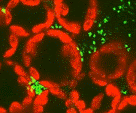Plant Pathology, Department of

Department of Plant Pathology: Faculty Publications
Document Type
Article
Date of this Version
11-1-1967
Abstract
Fluorescence is of diagnostic value for differentiating among species of aerobic pseudomonads (R. Y. Stanier, N. J. Palleroni, and M. Doudoroff, J. Gen. Microbiol. 43:159, 1966). The standard medium for detecting fluorescence is Medium B (E. 0. King, M. K. Ward, and D. E. Raney, J. Lab. Clin. Med. 44:301, 1954), which supports fluorescent pigment production of most pseudomonads tested (0. Jessen, Pseudomonas aeruginosa and other green fluorescent pseudomonads, A taxonomic study, Munksgaard, Copenhagen, 1965; R. Y. Stanier et al., J. Gen. Microbiol. 43:159, 1966). Minerals (J. V. King, J. J. R. Campbell, and B. A. Eagles, Can. J. Res. C 26:514, 1948), amino acids (J. De Ley, Ann. Rev. Microbiol. 18:17, 1964), and peptones (E. 0. King et al., J. Lab. Clin. Med. 44:301, 1954) affect fluorescence. The effect of carbon sources had not been shown. Although glycerol, glucose, or maltose can be used interchangeably in Medium B for detecting fluorescence of most fluorescent pseudomonads, this report shows that these carbon sources are not equivalent for phytopathogenic pseudomonads.


Comments
Published in APPLIED MICROBIOLOGY, Nov. 1967, p. 1523-1524. Copyright @ 1967 American Society for Microbiology. Used by permission.